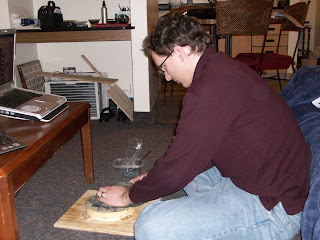




To actually grind the mirror, first some silicon carbide grit (later on we'll use finer sizes and softer compounds) is sprinkled on the tile tool. Then the tool is sprayed with water (mostly for health reasons- so that the ground glass dust is stuck in a slurry and can't be inhaled). Using moderate pressure the glass is pushed across the tile tool surface back and forth. Every few strokes the tool and mirror are rotated opposite ways. Every few minutes some new grit and new water are added. Every twenty minutes or so the glass and tool are both rinsed off in a bucket of water so the grit/glass slurry can't build up too much.
The first stroke, or "chordal stroke" has the glass overhanging the tool by about half, digging out the center of the glass. The "W stroke" is just like it sounds, moving the mirror across the tool in a W pattern. It will take the glass to a sphere, then a parabola, and eventually a hyperbola if done for too long. The "normal stroke" is just forward and backward with the mirror squarely on top of the tool (instead of offset by half like in the chordal stroke). All of these pictures show the chordal stroke.
In the end of this stage the glass should have a spherical curve ground to the proper radius of curvature. This spherical curve will later be polished with finer grit, and only at the end is the sphere figured into a true parabola.






